Tomb of Jesus with Rolling stone
Ancient Jewish Burial practices
"When it was
evening, there came a rich man from Arimathea, named Joseph,
who himself had also become a disciple of Jesus.
This man went to Pilate and asked for the body of Jesus.
Then Pilate ordered it to be given to him.
And Joseph took the body and wrapped it in a clean linen cloth,
and laid it in his own new tomb, which he had hewn out
in the rock;
and he rolled a large stone against the entrance of the tomb and went
away."
(Matthew 27:57-60)
Introduction:
1. Jesus was laid in a tomb cut out of rock with a rolling stone:
a. "When it was evening, there came a rich man from Arimathea, named Joseph, who himself had also become a disciple of Jesus. This man went to Pilate and asked for the body of Jesus. Then Pilate ordered it to be given to him. And Joseph took the body and wrapped it in a clean linen cloth, and laid it in his own new tomb, which he had hewn out in the rock; and he rolled a large stone against the entrance of the tomb and went away." (Matthew 27:57–60)
b. Jesus was laid on a stone slab and would have remained there for a year at which point his bones would have been placed in an ossuary.
c. However, Jesus “didn’t undergo decay” as the prophecy said, because he rose from the dead on the third day!
2. The Famous Garden Tomb is not the tomb of Jesus:
a. It is an Iron Age tomb, dating from the time of David-Josiah.
b. It is part of a series of tombs under the authority of Ecole Biblique which continues to the property of the garden tomb.
c. These tombs differ from first century tombs because they have no bone repositories or loculi
3. The Church of the Holy Sepulcher marks the actual location of the tomb of Jesus, cut out by Joseph of Arimathea:
a. In building the "Church of the Holy Sepulchre" in 325 AD, Eusebius records how Constantine even removed the soil on the tomb of Jesus that had been defiled by Hadrian and dumped it far away.
b. We are certain that the famous garden tomb is not the location of the tomb of Jesus Christ.
4. Detailed account of the original tomb of Jesus being marked by Eusebius in 325 AD: Eusebius, Vit. Const. 3.25–28
a. CHAPTER XXV: How he ordered the Erection of a Church at Jerusalem, in the Holy Place of our Saviour’s Resurrection: “AFTER these things, the pious emperor addressed himself to another work truly worthy of record, in the province of Palestine. What then was this work? He judged it incumbent on him to render the blessed locality of our Saviour’s resurrection an object of attraction and veneration to all. He issued immediate injunctions, therefore, for the erection in that spot of a house of prayer: and this he did, not on the mere natural impulse of his own mind, but being moved in spirit by the Saviour himself.”
b. CHAPTER XXVI: That the Holy Sepulchre had been covered with Rubbish and with Idols by the Ungodly: “FOR it had been in time past the endeavor of impious men (or rather let me say of the whole race of evil spirits through their means), to consign to the darkness of oblivion that divine monument of immortality to which the radiant angel had descended from heaven, and rolled away the stone for those who still had stony hearts, and who supposed that the living One still lay among the dead; and had declared glad tidings to the women also, and removed their stony-hearted unbelief by the conviction that he whom they sought was alive. This sacred cave, then, certain impious and godless persons had thought to remove entirely from the eyes of men, supposing in their folly that thus they should be able effectually to obscure the truth. Accordingly they brought a quantity of earth from a distance with much labor, and covered the entire spot; then, having raised this to a moderate height, they paved it with stone, concealing the holy cave beneath this massive mound. Then, as though their purpose had been effectually accomplished, they prepare on this foundation a truly dreadful sepulchre of souls, by building a gloomy shrine of lifeless idols to the impure spirit whom they call Venus, and offering detestable oblations therein on profane and accursed altars. For they supposed that their object could not otherwise be fully attained, than by thus burying the sacred cave beneath these foul pollutions. Unhappy men! they were unable to comprehend how impossible it was that their attempt should remain unknown to him who had been crowned with victory over death, any more than the blazing sun, when he rises above the earth, and holds his wonted course through the midst of heaven, is unseen by the whole race of mankind. Indeed, his saving power, shining with still greater brightness, and illumining, not the bodies, but the souls of men, was already filling the world with the effulgence of its own light. Nevertheless, these devices of impious and wicked men against the truth had prevailed for a long time, nor had any one of the governors, or military commanders, or even of the emperors themselves ever yet appeared, with ability to abolish these daring impieties, save only that one who enjoyed the favor of the King of kings. And now, acting as he did under the guidance of the divine Spirit, he could not consent to see the sacred spot of which we have spoken, thus buried, through the devices of the adversaries, under every kind of impurity, and abandoned to forgetfulness and neglect; nor would he yield to the malice of those who had contracted this guilt, but calling on the divine aid, gave orders that the place should be thoroughly purified, thinking that the parts which had been most polluted by the enemy ought to receive special tokens, through his means, of the greatness of the divine favor. As soon, then, as his commands were issued, these engines of deceit were cast down from their proud eminence to the very ground, and the dwelling-places of error, with the statues and the evil spirits which they represented, were overthrown and utterly destroyed.”
c. CHAPTER XXVII: How Constantine commanded the Materials of the Idol Temple, and the Soil itself, to be removed at a Distance: “NOR did the emperor’s zeal stop here; but he gave further orders that the materials of what was thus destroyed, both stone and timber, should be removed and thrown as far from the spot as possible; and this command also was speedily executed. The emperor, however, was not satisfied with having proceeded thus far: once more, fired with holy ardor, he directed that the ground itself should be dug up to a considerable depth, and the soil which had been polluted by the foul impurities of demon worship transported to a far distant place.”
d. CHAPTER XXVIII: Discovery of the Most Holy Sepulchre: “THIS also was accomplished without delay. But as soon as the original surface of the ground, beneath the covering of earth, appeared, immediately, and contrary to all expectation, the venerable and hollowed monument of our Saviour’s resurrection was discovered. Then indeed did this most holy cave present a faithful similitude of his return to life, in that, after lying buried in darkness, it again emerged to light, and afforded to all who came to witness the sight, a clear and visible proof of the wonders of which that spot had once been the scene, a testimony to the resurrection of the Saviour clearer than any voice could give.”
5. Burial practices vary over the period of Bible history.
a. In 2500 BC the Egyptians built the great pyramids of Giza as tombs for their kings.
b. 2100 BC: At the time of Abraham, burials were in simple caves and sometimes they built large rectangular memorial structures to mark the grave. (Tomb of Rachel)
c. 1500 BC: Ancient Canaanites would bury children inside of secondary use pithos jars, like the one excavated at Khirbet el-Maqatir.
i. “In 2009 an infant jar burial was discovered between two of these walls, in the northeast corner of Square O18. The burial jar was 15 in (37 cm) below the ground, resting on bedrock. Four offering vessels were placed around the outside of the jar, which faced south. In the MB period, grave goods were typically placed inside the burial jar, along with the remains of the interred, whereas in the LB I period placement outside the jar became more common. A hole had been cut into the bottom of the jar to insert the remains of the infant. This type of insertion is somewhat unusual since in the vast majority of infant jar burials the neck and rim were broken off, and insertion was made from the top of the jar. The mostly broken bones of an infant around the age of birth were found scattered around the outside of the jar. The remains had been removed from the jar in antiquity, undoubtedly by a rodent.” (ABR excavation report, 2009 season, Dr Bryant Wood)
d. At the time of David and Solomon, burials were in elaborate multi-level tombs.
e. At the time of the divided kingdom, sometimes after the body was placed in the tomb, they would have a memorial bonfire.
i. "Now it came about in the course of time, at the end of two years, that his bowels came out because of his sickness and he died in great pain. And his people made no fire for him like the fire for his fathers." (2 Chronicles 21:19)
ii. "They buried him in his own tomb which he had cut out for himself in the city of David, and they laid him in the resting place which he had filled with spices of various kinds blended by the perfumers’ art; and they made a very great fire for him." (2 Chronicles 16:14)
f. Elisha dies during the reign (812-798 BC) of Jehoahaz (Jehoash) king of Israel in 810 BC
i. In 810 BC Elisha was buried and placed in a tomb.
ii. When another burial was taking place, the Aram army attacked so they threw the dead body into Elijah’s tomb to make a quick get-away.
iii. When the dead body contacted the bones of Elisha, the man was resurrected.
iv. The timing on this final miracle “from the grave” of Elisha may have been up to a year after he died.
g. At the time of Christ, bones would be placed on a stone slab so the body would decay and fluids would exit via a drain. A year later the bones would be placed in an ossuary stone vessel box and placed inside an loculi for storage with many others as a final resting place.
I. Burial Practices in ancient Egypt: 1500 BC
1.
The Great Pyramids of Giza were burial tombs of Pharaohs.

2. The tower of Babel dates to about 1900 BC and was a pyramid shaped structure known as a Ziggurat.
3. Many cultures around the world used the basic pyramid shape for tombs and worship including north and south America.
a. The author was director of Excavations for a Ziggurat in central USA for the Hopewell Indians in 2015 AD.
II. Burial Practices at the time of Abraham: 2100 BC
1. 2100 BC: At the time of Abraham, burials were in simple caves as we see in Hebron and Shechem.
2.
Sometimes they built large rectangular memorial structures to mark the
grave. (Tomb
of Rachel)
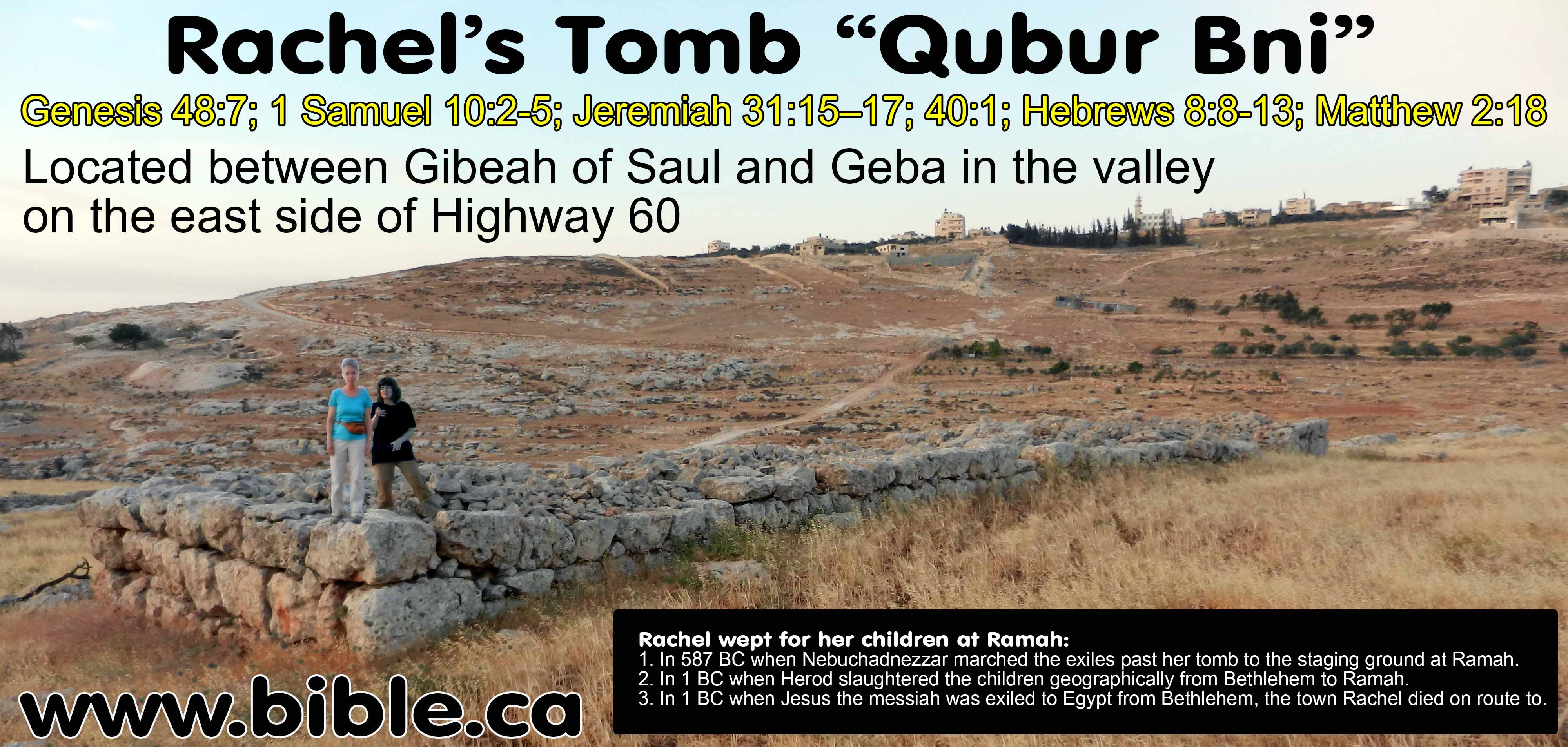
III. Burial Practices at the time of Joseph: 1865 BC
1. The tomb of Joseph and the Patriarchs at Tel el Dab’a (Avaris, Goshen)
a. Excavated by the Austrian team, but identified by David Rohl, a mortuary structure of 12 tombs surrounding a central tomb has been identified as that of Joseph and the other twelve sons of Jacob.
b. A portion of the head of a stone statue that features a non-Egyptian “Semitic” hair style with traces of a multi colored coat.
c.
At the time of the exodus, (1446BC) there are deliberate chisel marks on
the head.
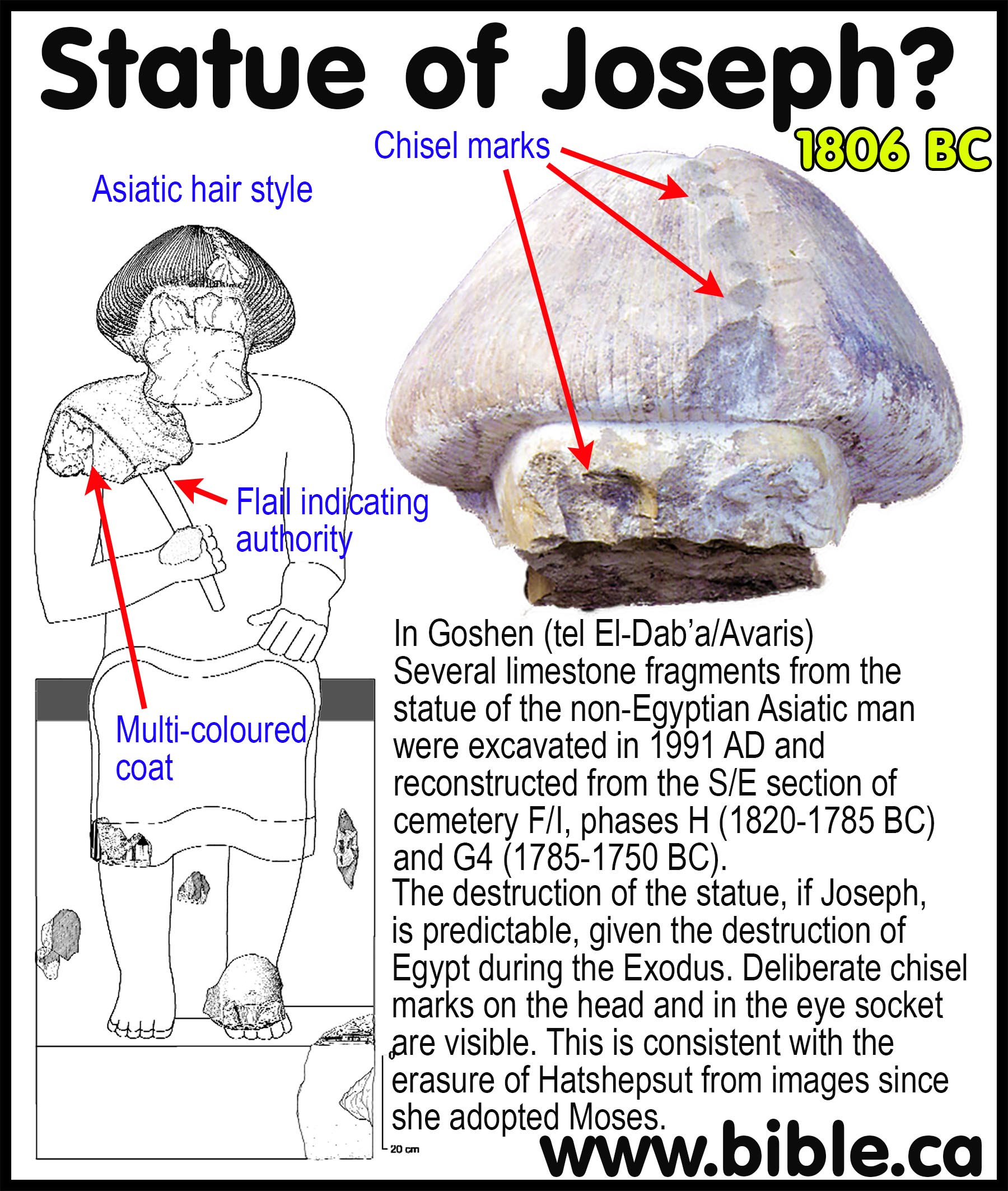
d.
This is consistent with the erasure of Hatshepsut after the Exodus, who
adopted Moses. The Egyptians blamed Hatshepsut for the destruction of Egypt
through the ten plagues because she adopted Moses.
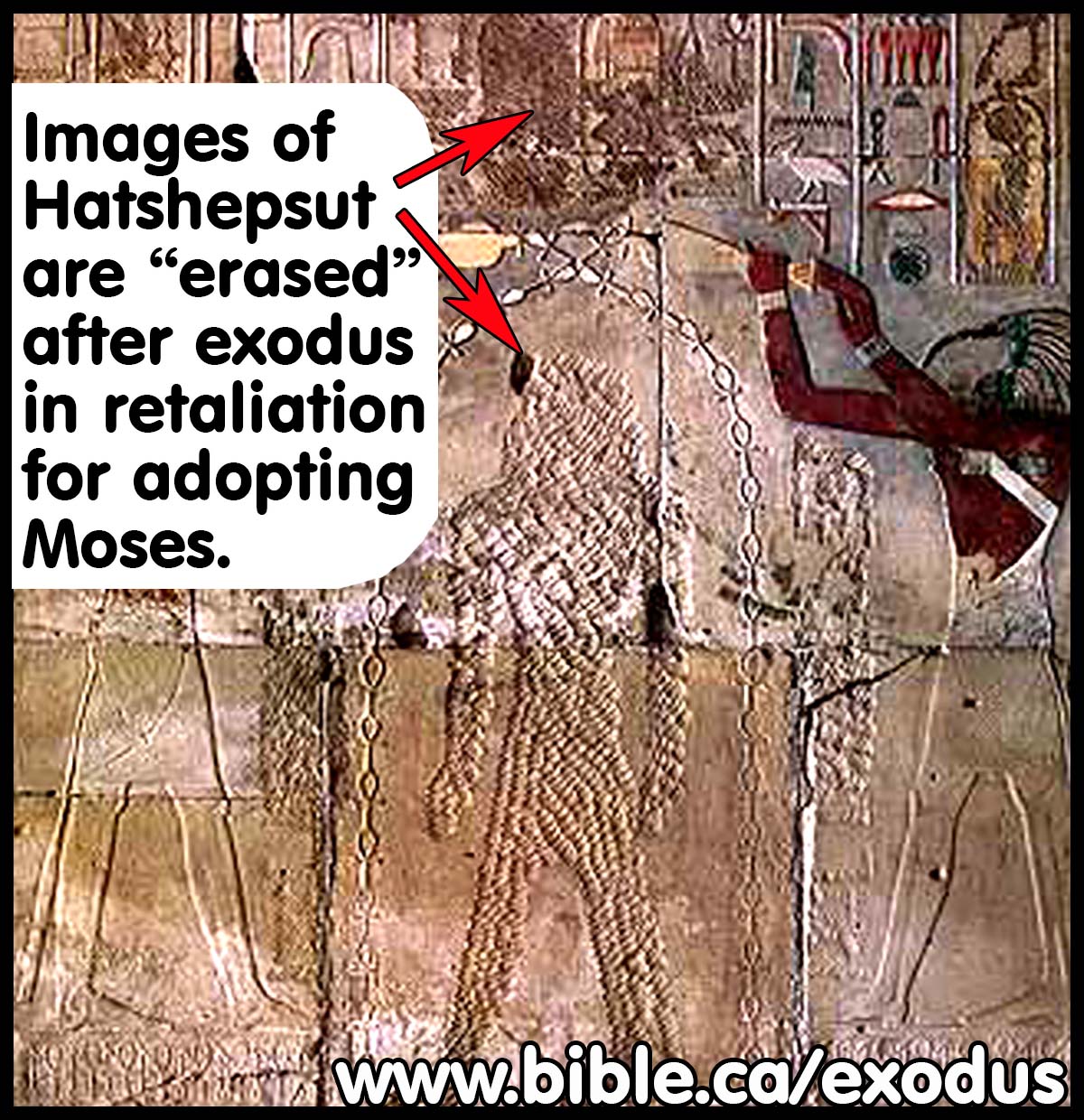
2. The tomb of Joseph at Shechem had many buildings over its history erected over the site.
a. Pictured here is the crusader structure as seen in 1865 AD.
b.
While the structures are relatively modern, the spot is most certainly
correct, as is the location of Jacob’s well.
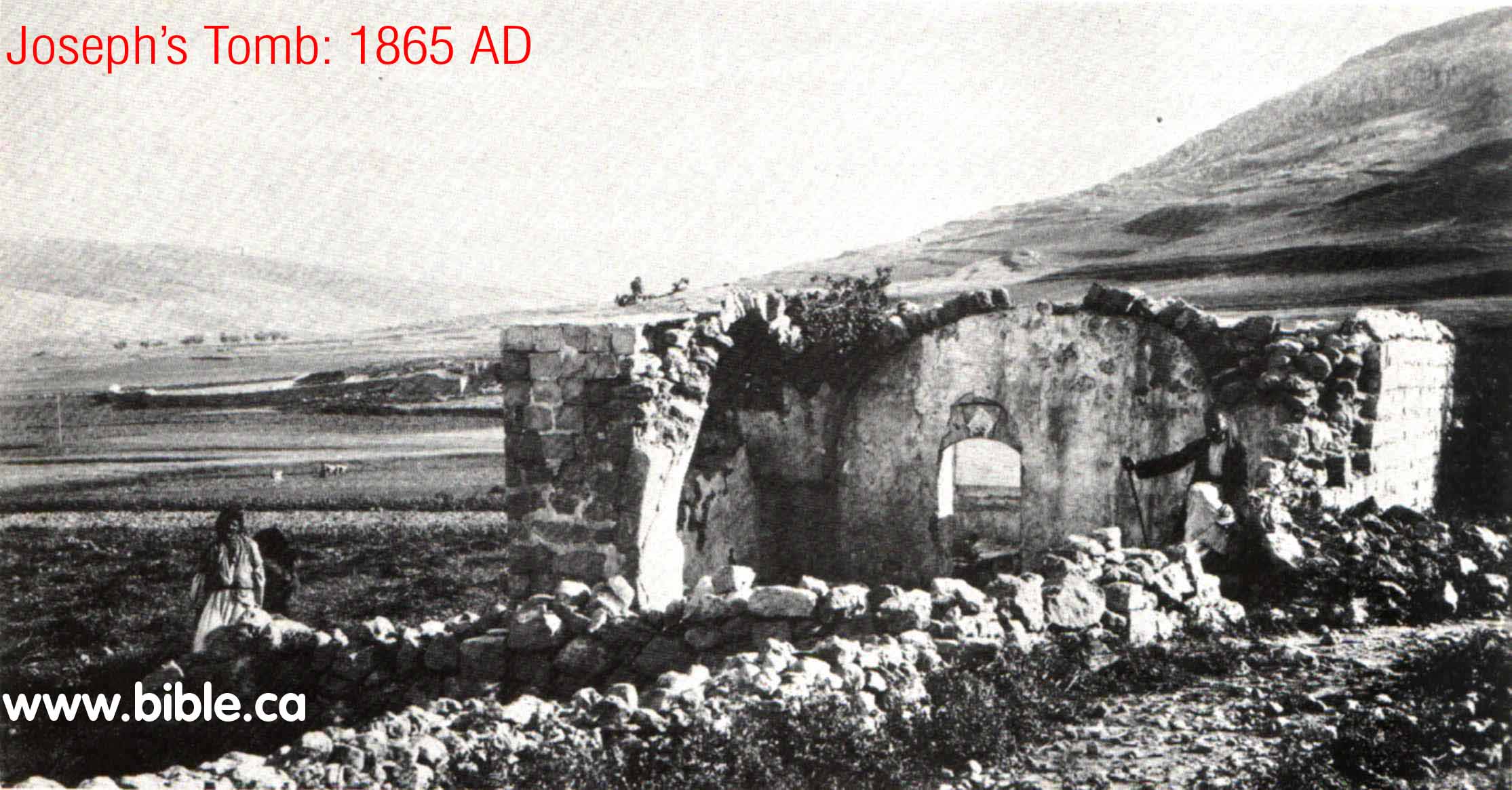
IV. Burial Practices at the time of Moses: 1446 BC
1. The Egyptians built pyramids and elaborately decorated tombs.
2.
The tomb of Rekhmire the Vizier in Thebes (Luxor tomb TT100) dates to
the pharaoh of the Exodus: 1446 BC
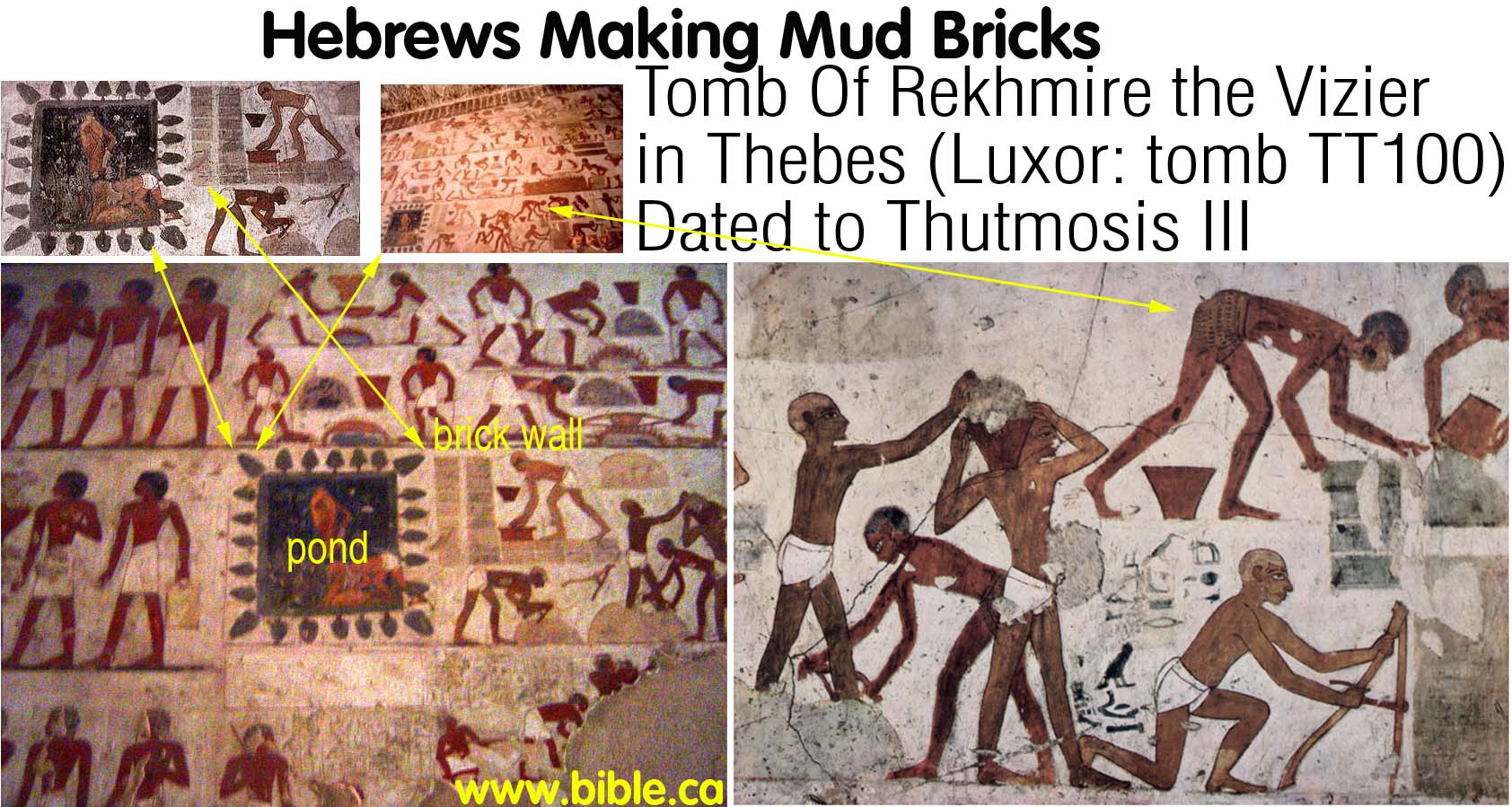
V. Burial Practices at the time of David and Solomon: 960-931 BC
1.
You can visit David’s and Solomon’s tombs today in Jerusalem. They are
side by side and multi-level cut out of solid rock. Located near the pool of
Shilom.

2. Solomon built a tomb for Pharaoh’s daughter whom he married in violation of the law:
a. "Then Solomon formed a marriage alliance with Pharaoh king of Egypt, and took Pharaoh’s daughter and brought her to the city of David until he had finished building his own house and the house of the LORD and the wall around Jerusalem." (1 Kings 3:1)
b.
"Then Solomon brought Pharaoh’s daughter up from the city of David
to the house which he had built for her, for he said, “My wife shall not dwell
in the house of David king of Israel, because the places are holy where the ark
of the LORD has entered.”" (2 Chronicles 8:11)
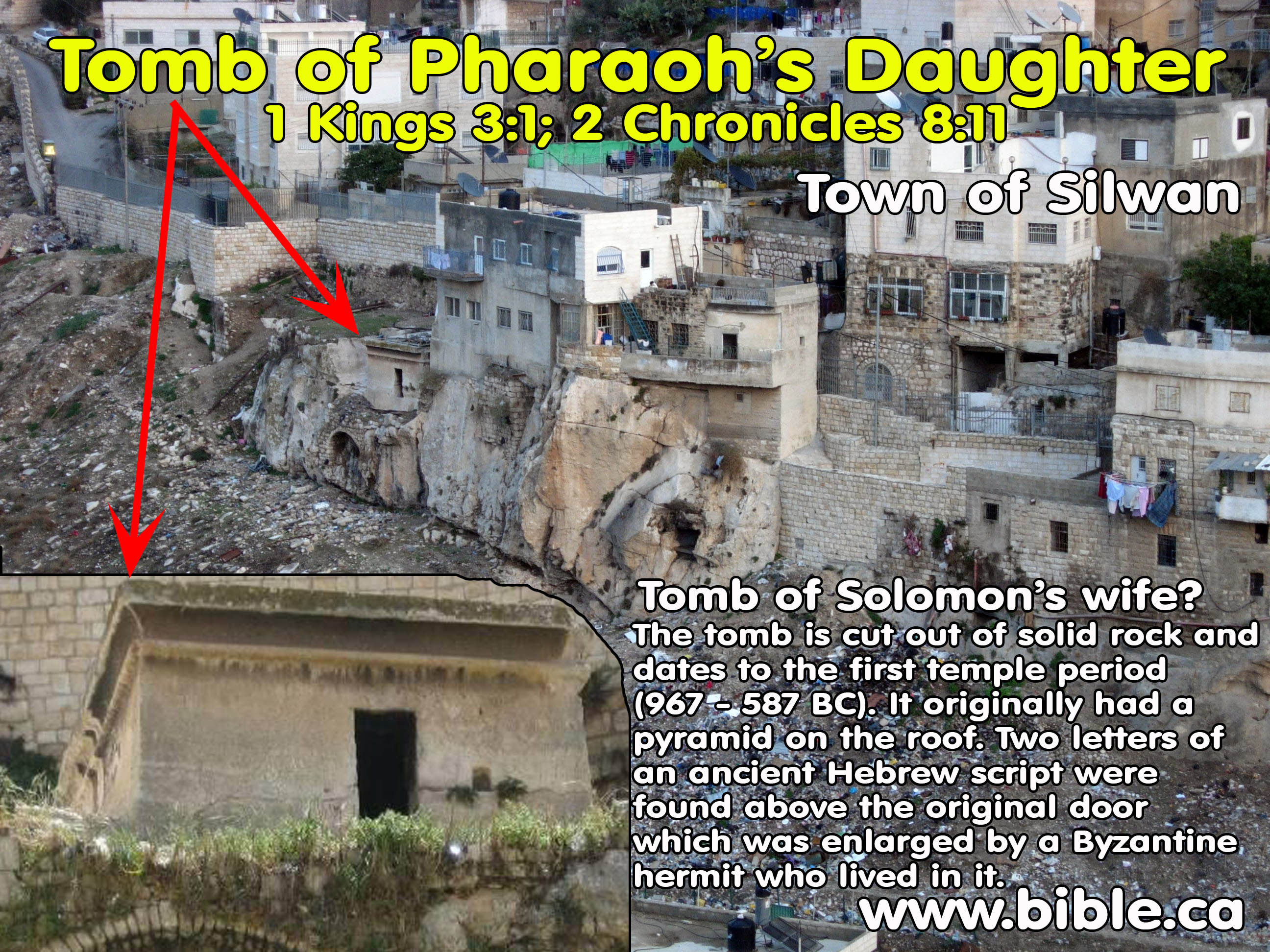
VI. Burial Practices at the time of Isaiah: 700 BC
1. The tomb of Shebnah can be seen today in Jerusalem.
2.
"Thus says the Lord God of hosts, “Come, go to this steward, To
Shebna, who is in charge of the royal household, ‘What right do you have here,
And whom do you have here, That you have hewn a tomb for yourself here, You who
hew a tomb on the height, You who carve a resting place for yourself in the
rock? ‘Behold, the Lord is about to hurl you headlong, O man. And He is about
to grasp you firmly" (Isaiah 22:15–17)
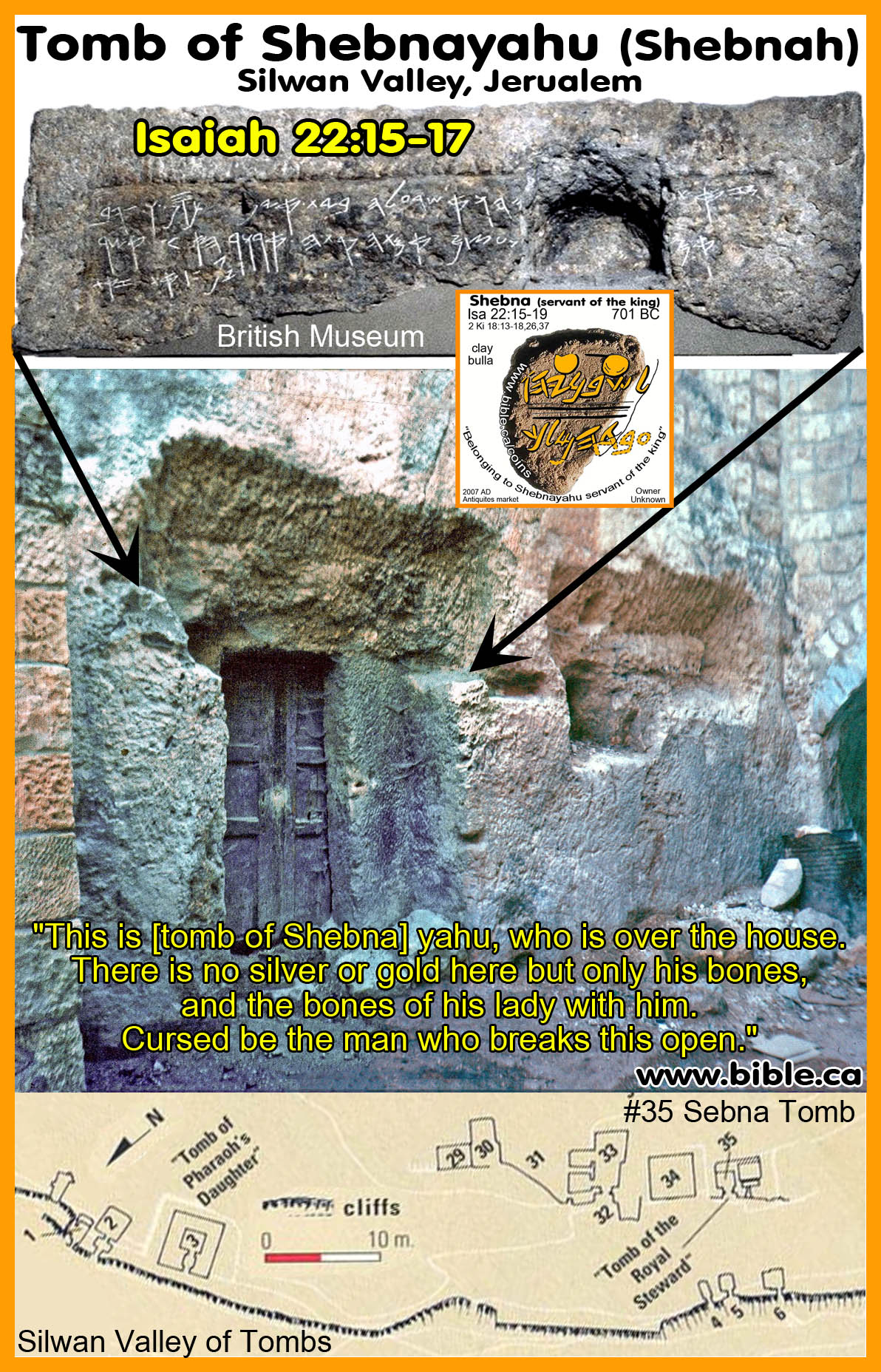
VII. First Century Burial Practices at the time of Jesus of Nazareth:
1. In the first century, Jews would place a dead body on a rock platform inside a rock cut tomb that featured finger-like sections called Koch (singular, also called Kokh or loculus).
2.
Most ancient tombs featured many kochim (plural of Kokh, also called
loculi). Here is a first century tomb excavated by Associates of Biblical
research under the direction of Dr. Bryant Wood in the AD 2000 excavation
season that featured 7 loclui:

3.
Here is the tomb complex at Mareshah in Israel with the author sitting
in the middle loculus:

4.
This is the first century tomb of Helena, Queen of Adiabene and Edessa
located in Jerusalem. It features body decay slabs (1 year process), body fluid
drains and many loculi in which to store the ossuary bone boxes. They also had
rolling stone doors to and seals to protect the contents from tampering. The
tomb of Helena is typical of the kind of tomb with rolling stone that Jesus of
Nazareth was buried in. He would have been placed on a stone slab as pictured
below wrapped in white linen cloth. They also had many oil lamp niches in the
walls for light.

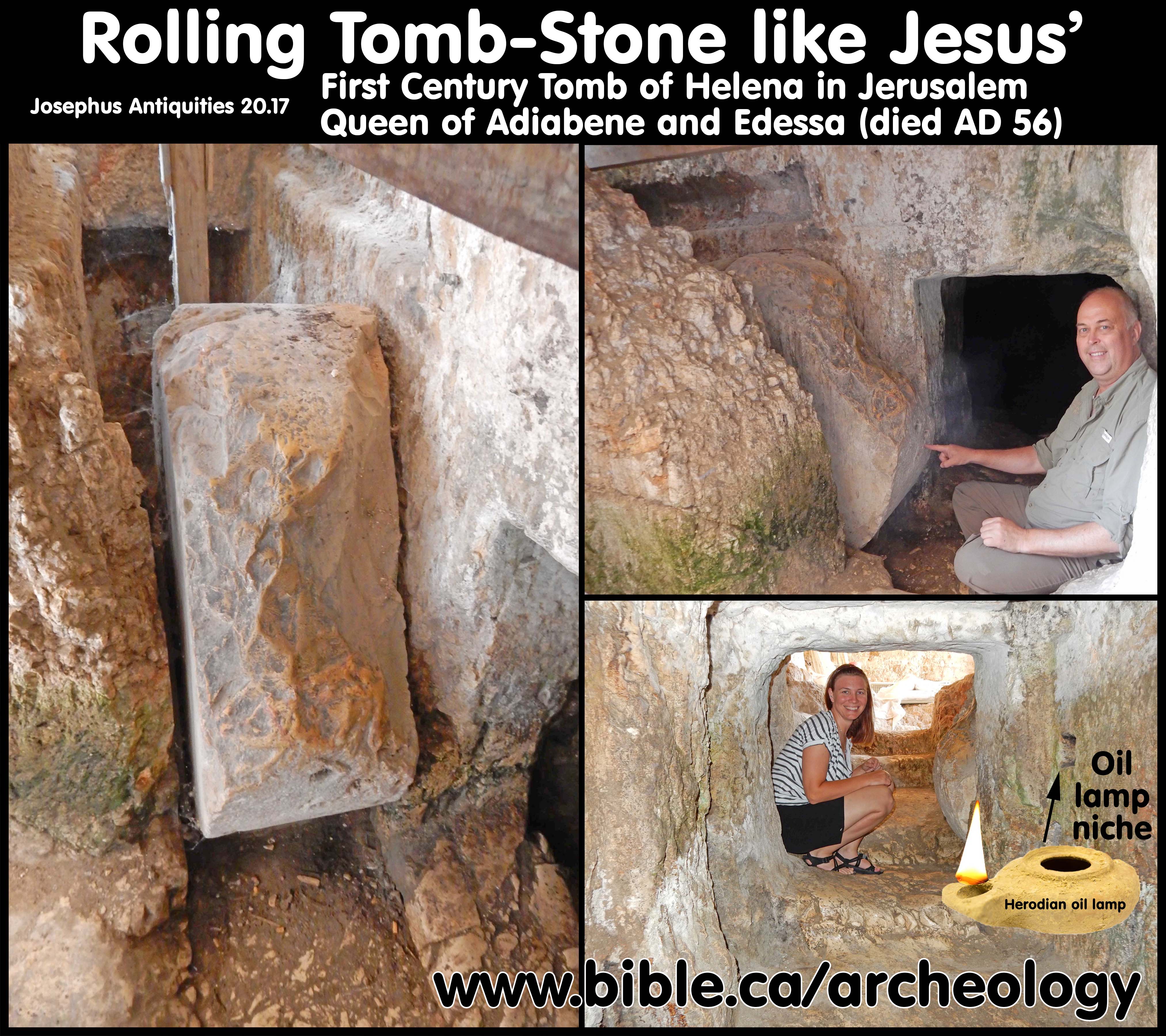
5. Ossuaries were cut from soft limestone, quarried in the Jerusalem area.
6.
Here is the ossuary of Caiaphas the high priest of Mt 26:57.
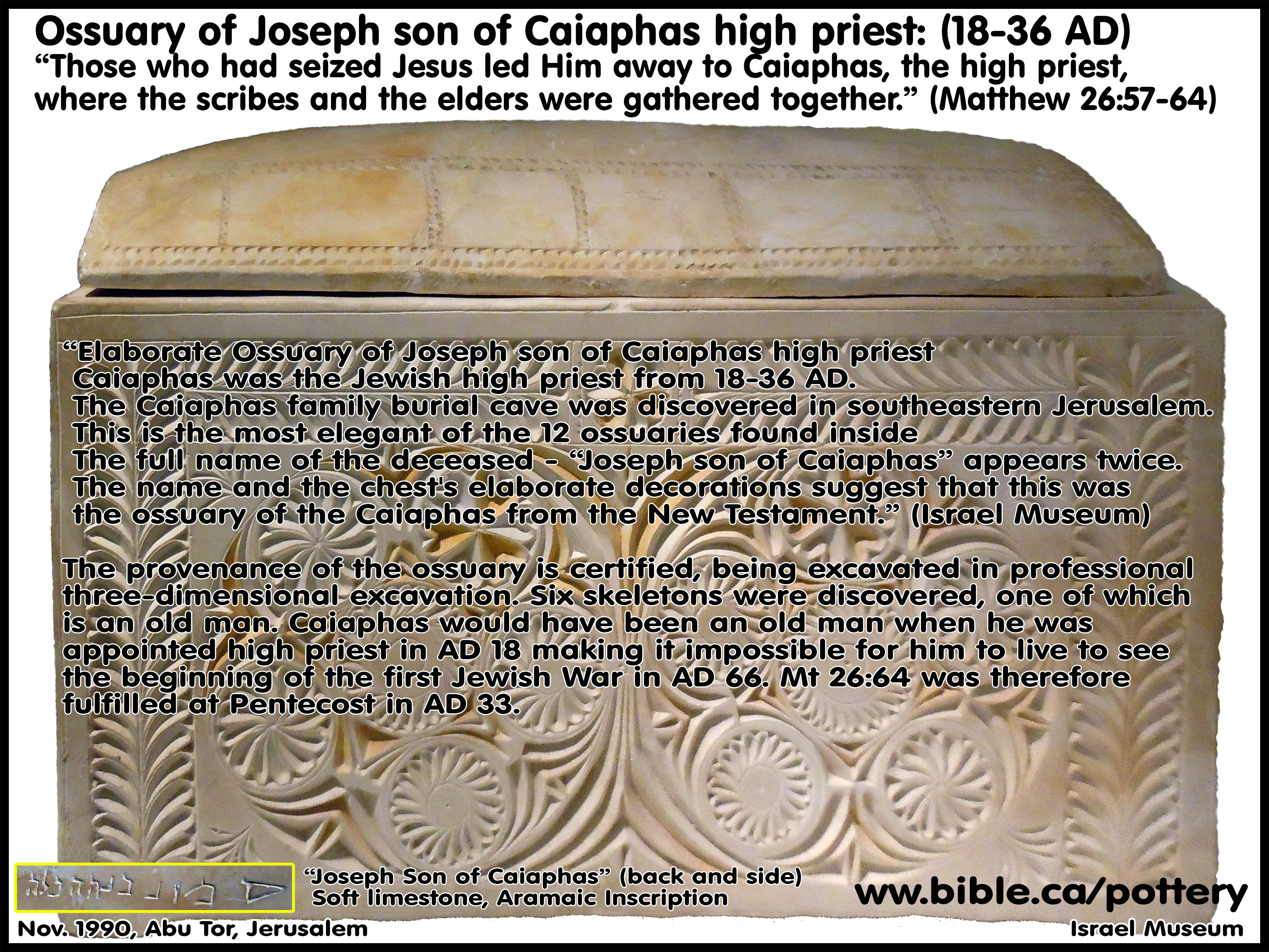
Conclusion:
1. Jesus has risen from the dead and the tomb is empty!
2. The Garden tomb near the old City of Jerusalem is certainly not the tomb of Jesus.
3. We can be the most certain that the tomb of Jesus is under the Church of the Holy Sepulcher.
By Steve Rudd: Contact the author for comments, input or corrections.

